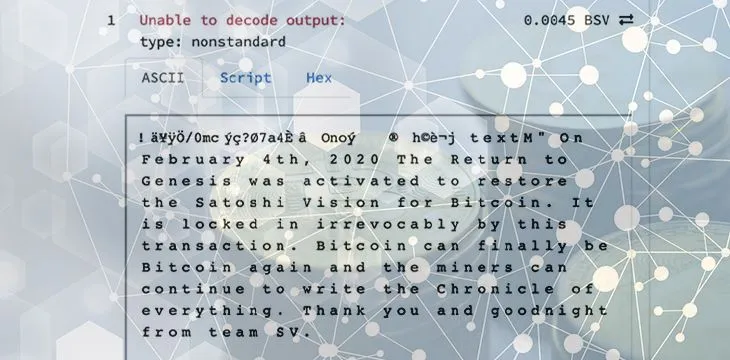|
Getting your Trinity Audio player ready...
|
The 11-year wait for Bitcoin v1.0.0 ended February 4, 2020, with the activation of “Genesis”. Bitcoin’s base protocol has now returned to Satoshi Nakamoto’s original vision and functionality. Following years of wrangling, intrigue, power-plays and chain splits, miners activated the software on the mainnet with messages of thanks for Satoshi.
The first block to follow Genesis rules was at block height #620538, at 1:35AM UTC on February 4. It was 1.84MB in size and contained 725 transactions. Curiously, its miner was listed as “unknown” on block explorers. Mining firm TAAL then locked Genesis in by mining block #620539.
TAAL’s block #620539, which confirmed the new Genesis rules (by creating a “chain” since the activation) contained a message to mark the occasion:
A historic moment in block 620539 that confirmed new #Genesis rules as valid on #BitcoinSV #BSV. Block mined by @TaalBlockchain and message delivered by @shadders for @BitcoinSVNode team.
It's a good night from Team SV . . . and a new dawn for Bitcoin. ☀️ pic.twitter.com/UUbPy12KTX
— Jimmy Nguyen (@iamJimmyWIN) February 4, 2020
It read: “On February 4th, 2020 The Return to Genesis was activated to restore the Satoshi Vision for Bitcoin. It is locked in irrevocably by this transaction. Bitcoin can finally be Bitcoin again and the miners can continue to write the Chronicle of everything. Thank you and goodnight from team SV.”
TAAL had mined the final six blocks under the previous protocol version, codenamed “Quasar”. Starting with block #620535, the third-last, it began to include the line “on behalf of Satoshi Nakamoto” in its coinbase text.
"https://t.co/j0TertyWQu on behalf of Satoshi Nakamotoi" #BSV pic.twitter.com/asO9SMWS1t
— Truth_Machine, Follower of Jesus, Lover of Truth. (@cryptorebel_SV) February 4, 2020
All subsequent blocks mined by TAAL and CoinGeek have included the same tagline, while other miners such as Mempool/Nourpool and BTCC have confirmed blocks without any special change to their signaling text.
The block of the unknown miner
The “unknown” miner at block #620538 (the Genesis activation block) also did not include any special signal or other clue as to who they may be.
It’s customary, though not obligatory, for miners and mining pools to signal their identities in the coinbase text of blocks they mine. This aids data and statistics sites in visualizing the share of hashing power on each network. It also functions as a PR boost if a company or pool mines a statistically significant block, eg: one of record size, or the first after a software upgrade.
Statistically, it would have been a coincidence for an unknown miner to mine such a significant block. Unidentified miners (who could be all individuals, acting as a group, or a mixture of both) today comprised 18.06% of the Bitcoin SV network as “Other”. However, over the past week, “other” miners mined 40.3% of BSV blocks.
“Unknown” miners have always generated much curiosity in Bitcoin discussion circles. They may represent good or bad actors, a sign of strength or a reason to be anxious. Sometimes they leave hints (which could also be false leads) as to who they might be… and sometimes nothing at all.
The overall hashing power available on BSV increased markedly around the middle of January 2020, topping 3,000 petahashes per second (PH/s). That’s more than double the average hash power of BSV since the November 2018 hard fork that split the network away from BCH).

 07-03-2025
07-03-2025 





